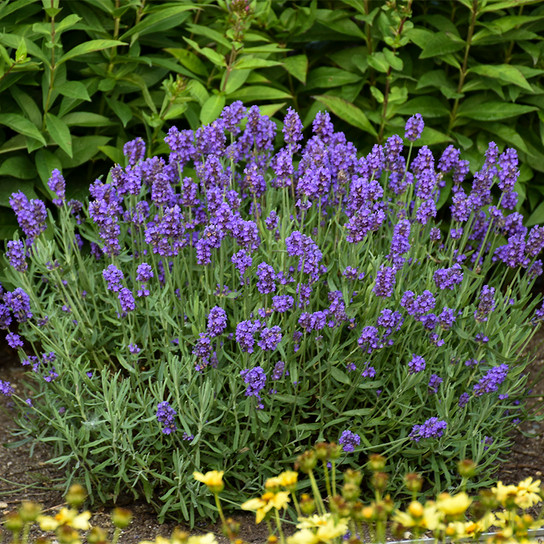
Lavender
Uses:
- Borders
- Xeriscaping
- Pollinator Gardens
- Herb & Sensory Gardens
Features:
- Deer Resistant
- Drought Tolerant
- Attracts Butterflies and Bees
- Aromatic Leaves
Sunlight:
- Full Sun
- 6+ Hours of Direct Sun
Growing Zones:
- 5-9
- What is My Zone?
Lavender is a tough evergreen shrub with a long blooming period. Tiny purple flowers bloom along upright stems in early summer and attract butterflies and bees. The silver to gray-green foliage is evergreen and contains the same fragrant oils found in the flowers. These small shrubs have a mounded form and remain compact with an annual trimming. Use lavender in xeriscapes, herb gardens, and Mediterranean-themed plantings for many years of low-maintenance beauty.
About Lavender

English Lavender, French Lavender, Spanish Lavender
Mountainous zones of the Mediterranean
Perennials
Herbaceous
5-10
White, Pink, Blue-violet, purple
Spring to summer
Mounded
Butterflies, bees and other insects
Heat, Humidity, Drought
Disease, Pests, Deer
How To Use Lavender In The Garden
Lavender's silver-green foliage and famously scented flower spikes have earned it a revered spot in both culinary and ornamental circles. Bees are drawn to the nectar-rich flowers. Home gardeners favor it for dried arrangements, fragrant oils, and challenging landscape sites. Adaptable to full sun, rocky soils, and dry climates, lavender takes center stage in many drought-tolerant plantings.
Lavender's compact form makes it suitable for borders, hedges, or accenting. Pair it with pastel perennials for a gentle color palette or group it among more intense tones of Mediterranean shrubs. Use clipped mounds to establish a sense of order, or let it intermingle with ornamental grasses in airy borders. The fragrant blooms can be harvested for use in dried arrangements or sachets, adding a sensory element to your garden's produce.
Lavender Care
Lavender thrives in lean, sandy soils with sharp drainage, demanding full sun (6+ hours daily) and minimal summer watering once roots establish. Plant in spring after frost risk passes; amend dense clay with gravel or grit to mimic Mediterranean conditions. Avoid nutrient-rich amendments—this drought-tolerant perennial prefers slightly alkaline soil (pH 6.7-7.3) and declines in overly fertile or soggy ground. Water deeply but infrequently during establishment, then rely on rainfall; overwatering invites root rot.
Lavender thrives in lean, sandy soils with sharp drainage, demanding full sun (6+ hours daily) and minimal summer watering once roots establish. Plant in spring after frost risk passes; amend dense clay with gravel or grit to mimic Mediterranean conditions. Avoid nutrient-rich amendments—this drought-tolerant perennial prefers slightly alkaline soil (pH 6.7-7.3) and declines in overly fertile or soggy ground. Water deeply but infrequently during establishment, then rely on rainfall; overwatering invites root rot.
Learn More About Lavender

Lavender Companion Plants
Lavender companions should welcome free‑draining soil that never stays soggy, lean fertility, and a spot basking in all‑day sun. Upright rosemary mirrors lavender’s Mediterranean thirst for dryness while doubling the fragrance quotient. Use silvery creeping thyme at the base to echo the foliage tone and hide bare stems. Statuesque agapanthus punctuates the planting with bold blue globes that flower in the same heat‑loving window, and agastache threads bright oranges and pinks through the bed without demanding more water or fertilizer than lavender can spare.























